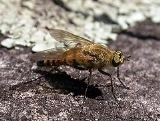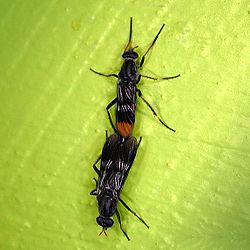
Therevidae
Encyclopedia

Diptera
Diptera , or true flies, is the order of insects possessing only a single pair of wings on the mesothorax; the metathorax bears a pair of drumstick like structures called the halteres, the remnants of the hind wings. It is a large order, containing an estimated 240,000 species, although under half...
Asiloidea
Asiloidea
Asiloidea is a very large cosmopolitan superfamily of Diptera. The former infraorder Asilomorpha is paraphyletic and thus not a natural group; as its type taxon the Asiloidea would still belong there in any case, but current knowledge of brachyceran relationships would make it monotypic: the...
commonly known as stiletto flies. The family contains about 1,600 described species worldwide, most diverse in arid and semi-arid
Semi-arid
A semi-arid climate or steppe climate describes climatic regions that receive precipitation below potential evapotranspiration, but not extremely...
regions with sandy soils. The larvae are predators of insect larvae in soil.
Family characteristics
Species lists
- Palaearctic
- Nearctic
- Australasian/Oceanian
- Japan
- List of soldierflies and allies of Great Britain
Identification
Cole, F.R., 1923. A revision of the North American two-winged flies of the family Therevidae. Proceedings of the U.S. National Museum, 62(4), 1-140.Cole, F.R., 1960 Stiletto-flies of the genus Furcifera Kröber (Diptera: Therevidae). Annals of the Entomological Society of America, 53, 160-169.
Gaimari, S.D., & M.E. Irwin , 2000. Phylogeny, classification, and biogeography of the cycloteline Therevinae (Insecta: Diptera: Therevidae). Zoological Journal of the Linnean Society, 129, 129-240.
Irwin, M.E., & L. Lyneborg, 1981. The genera of Nearctic Therevidae. Illinois Natural History Bulletin, (1980) 32, 193-277.
Irwin, M.E., & D.W. Webb, 1992. Brasilian Therevidae (Diptera): a checklist and descriptions (sic) of species. Acta Amazonica, (1991) 21, 85-121.
Kröber, O. , 1911. Die Thereviden Süd- und Mittelamerikas. Annales Musei Nationalis Hungarici, 9, 475-529. Keys genera, species.
Kröber, O. , 1912. Die Thereviden der indo-australischen Region. Keys genera, species.
Kröber, O. , 1913. Therevidae.Genera.Ins. Keys (then) world genera. Keys genera, species.
Kröber, O. , 1914. Beiträge zur Kenntnis der Thereviden und Omphraliden. Jahrbuch der Hamburgischen Wissenschaftlichen Anstalten, (1913) 31, 29-74.
Kröber, O. , 1924_1925. Therevidae. Fiegen palaerakt. Reg. 4 (26):1-60
Kröber, O. , 1928. Neue und wenig bekannte Dipteren aus den Familien Omphralidae, Conopidae, und Therevidae. Konowia Zeitschrift für Systematische Insektenkunde, 7, 113-134.
Kröber, O. , 1931. The Therevidae (Diptera) of South Africa. Ann. Transv. Mus.. 14:103-134. (see also Lyneborg).
Lyneborg, L. 1972. A revision of the Xestomyza-group of Therevidae. (Diptera). Annals of the Natal Museum 21: 297–376. Keys African genera, species.
Lyneborg, L. 1976. A revision of the Therevine stiletto-flies (Diptera: Therevidae) of the Ethiopian Region. Bull. British Mus. (Nat. Hist.). Entomology 33 (3): 191-346. Keys subfamilies and genera of Thervinae.
Malloch, J. R. 1932. Rhagionidae, Therevidae. British Museum (Natural History). Dept. of Entomology [eds] Diptera of Patagonia and South Chile, based mainly on material in the British Museum (Natural History). Part V. Fascicle 3. - Rhagionidae (Leptidae), Therevidae, Scenopenidae, Mydaidae, Asilidae, Lonchopteridae. pp. 199–293. Keys genera, species.
Mann, JS.1928-1933 Revisional notes on Australian Therevidae. Part 1. Australian Zoologist, 5, 151–. 194 (1928); Part 2 6:17-49 (1929); Part 3 7:325-344. (1933).

